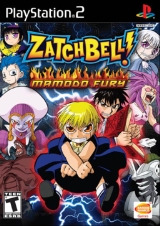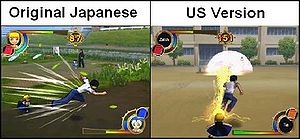
Zatch Bell! Mamodo Fury
Encyclopedia
is a fighting game released on the PlayStation 2
. The original Japanese version was published by Bandai
at the end of 2005, after merging with Namco
but before the formation of Namco Bandai Games
. The subsequent international releases and the GameCube versions were published under Namco Bandai Games. The game is based on the Zatch Bell!
franchise.
Arcade Mode: Choose a character and fight against eight opponents. Once completed, a special cut-scene for the chosen character will play that contains dialogue between the mamodo and his or her partner. After the scene concludes you will see the statistics
of all eight matches. These statistics determine the chance of the mamodo becoming King. To receive a 100% rating, all matches must be one with an "A" rating.
VS. Mode: This is a traditional one-on-one battle. Choose any character and stage and begin fighting immediately. Play can either be against CPU opponents or other people via two controllers. A ranking up system is also available. Stats for individual characters can be upgraded by the obtaining of "Mamodo Points", which are distributed after the conclusion of a match. The amount of points given is based on the aforementioned ranking system, with "A" being the best and "E" being the worst.
4P Battle: Meant as more of a party mode, the 4P battles are in the form of mini games. These include "Burn the Spell Book", which has each player try to kick another's spell book into a small campfire, among others.
Mini-Games: This game mode contains seven mini games where certain goals must be completed. One level requires you to find 30 lollipops and give them to Kanchome within 80 seconds.
Gallery: The Gallery is split into several subtypes: the Model Gallery, which shows all the character models used in the game along with a short description of each; Visual Gallery, which has all the cut scenes from the Story Mode; Stage Gallery, which lets the player control Suzy Mizuno and roam freely along the multiplayer stages; and the Sound Gallery, which contains all the music from the game.
 Some levels from Story Mode were taken out of the American version, and a few were given different winning objectives. Some cutscene
Some levels from Story Mode were taken out of the American version, and a few were given different winning objectives. Some cutscene
s in the GC version play no music at all, while (almost) all cutscenes play music in the PS2 version.
There are a few cosmetic changes to the HUD
as well. The icons of the mamodo in the Japanese version are removed, the indicators merely showing the character names instead. Also, in the Japanese version in Story Mode, character reactions are visible in both up-right and down-left screens. However in the U.S. version they don't appear, although some of the dialogue remains.
Since both the PlayStation 2
& GameCube
have different graphic rendering, there are many differences between the lighting, rendering and textures on both versions.
There are some graphic problems with the exclusive U.S. GameCube
version of the game.
PlayStation 2
The PlayStation 2 is a sixth-generation video game console manufactured by Sony as part of the PlayStation series. Its development was announced in March 1999 and it was first released on March 4, 2000, in Japan...
. The original Japanese version was published by Bandai
Bandai
is a Japanese toy making and video game company, as well as the producer of a large number of plastic model kits. It is the world's third-largest producer of toys . Some ex-Bandai group companies produce anime and tokusatsu programs...
at the end of 2005, after merging with Namco
Namco
is a Japanese corporation best known as a former video game developer and publisher. Following a merger with Bandai in September 2005, the two companies' game production assets were spun off into Namco Bandai Games on March 31, 2006. Namco Ltd. was re-established to continue domestic operation of...
but before the formation of Namco Bandai Games
Namco Bandai Games
is an arcade, mobile and home video game developer and publisher based in Japan which is the product of a merger between the video game development divisions of Bandai and Namco. Namco Bandai Games is a wholly owned subsidiary of Namco Bandai Holdings and specializes in production and sales of...
. The subsequent international releases and the GameCube versions were published under Namco Bandai Games. The game is based on the Zatch Bell!
Zatch Bell!
Zatch Bell!, known in Japan as is a shōnen manga series written and illustrated by Makoto Raiku. It was published in Shogakukan's Weekly Shōnen Sunday...
franchise.
Game modes
Story Mode: Play is done over the course of 40 levels consisting of different opponents. Often special conditions will need to be met, such as defeating an opponent with Bao Zakeruga. Note that this does not necessarily mean that the opponent be at minimum health. In addition to the regular Story Mode there is a series of mini games which are consolidated into "Zatch's Diary". These follow every day situations in Zatch's life. Previously played levels can be reselected either to improve rating or on higher difficulties.Arcade Mode: Choose a character and fight against eight opponents. Once completed, a special cut-scene for the chosen character will play that contains dialogue between the mamodo and his or her partner. After the scene concludes you will see the statistics
Statistics
Statistics is the study of the collection, organization, analysis, and interpretation of data. It deals with all aspects of this, including the planning of data collection in terms of the design of surveys and experiments....
of all eight matches. These statistics determine the chance of the mamodo becoming King. To receive a 100% rating, all matches must be one with an "A" rating.
VS. Mode: This is a traditional one-on-one battle. Choose any character and stage and begin fighting immediately. Play can either be against CPU opponents or other people via two controllers. A ranking up system is also available. Stats for individual characters can be upgraded by the obtaining of "Mamodo Points", which are distributed after the conclusion of a match. The amount of points given is based on the aforementioned ranking system, with "A" being the best and "E" being the worst.
4P Battle: Meant as more of a party mode, the 4P battles are in the form of mini games. These include "Burn the Spell Book", which has each player try to kick another's spell book into a small campfire, among others.
Mini-Games: This game mode contains seven mini games where certain goals must be completed. One level requires you to find 30 lollipops and give them to Kanchome within 80 seconds.
Gallery: The Gallery is split into several subtypes: the Model Gallery, which shows all the character models used in the game along with a short description of each; Visual Gallery, which has all the cut scenes from the Story Mode; Stage Gallery, which lets the player control Suzy Mizuno and roam freely along the multiplayer stages; and the Sound Gallery, which contains all the music from the game.
Changes to the US version

Cutscene
A cutscene is a sequence in a video game over which the player has no or only limited control, breaking up the gameplay and used to advance the plot, strengthen the main character's development, introduces enemy characters, and provide background information, atmosphere, dialogue, and clues...
s in the GC version play no music at all, while (almost) all cutscenes play music in the PS2 version.
There are a few cosmetic changes to the HUD
HUD (video gaming)
In video gaming, the HUD is the method by which information is visually relayed to the player as part of a game's user interface...
as well. The icons of the mamodo in the Japanese version are removed, the indicators merely showing the character names instead. Also, in the Japanese version in Story Mode, character reactions are visible in both up-right and down-left screens. However in the U.S. version they don't appear, although some of the dialogue remains.
Since both the PlayStation 2
PlayStation 2
The PlayStation 2 is a sixth-generation video game console manufactured by Sony as part of the PlayStation series. Its development was announced in March 1999 and it was first released on March 4, 2000, in Japan...
& GameCube
Nintendo GameCube
The , officially abbreviated to NGC in Japan and GCN in other regions, is a sixth generation video game console released by Nintendo on September 15, 2001 in Japan, November 18, 2001 in North America, May 3, 2002 in Europe, and May 17, 2002 in Australia...
have different graphic rendering, there are many differences between the lighting, rendering and textures on both versions.
There are some graphic problems with the exclusive U.S. GameCube
Nintendo GameCube
The , officially abbreviated to NGC in Japan and GCN in other regions, is a sixth generation video game console released by Nintendo on September 15, 2001 in Japan, November 18, 2001 in North America, May 3, 2002 in Europe, and May 17, 2002 in Australia...
version of the game.
- In the GameCubeNintendo GameCubeThe , officially abbreviated to NGC in Japan and GCN in other regions, is a sixth generation video game console released by Nintendo on September 15, 2001 in Japan, November 18, 2001 in North America, May 3, 2002 in Europe, and May 17, 2002 in Australia...
version, the stage "Front of Windmill" has a black background instead of a sky background. This might be because the sky texture on that stage was either corupted or missing. - The frame-rate in the GameCubeNintendo GameCubeThe , officially abbreviated to NGC in Japan and GCN in other regions, is a sixth generation video game console released by Nintendo on September 15, 2001 in Japan, November 18, 2001 in North America, May 3, 2002 in Europe, and May 17, 2002 in Australia...
version sometimes drops, usually when you and/or the camera is too close to the spell's graphics. It also happens on 2P mode in the stage "Roof of Abandoned Building". It happens if you just stand at your starting position, and the camera is pointing not only at the back of you, but inside the outside scenery as well.

